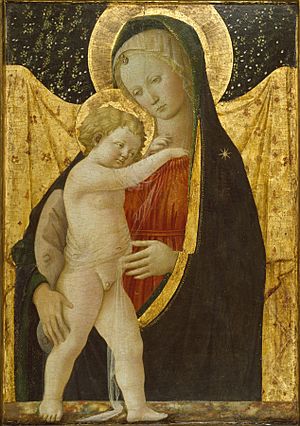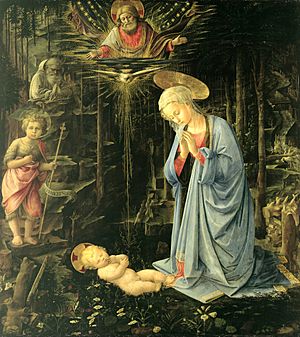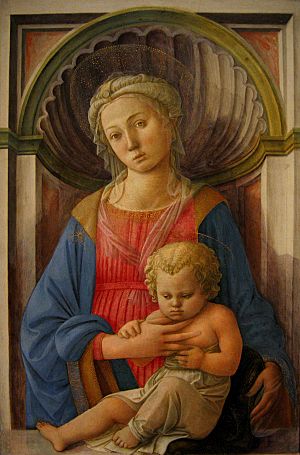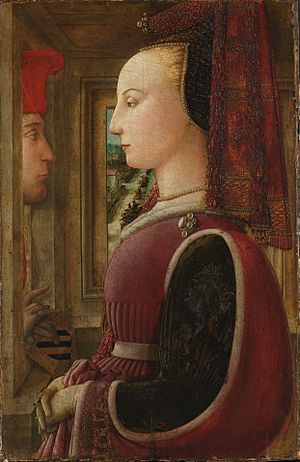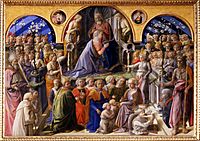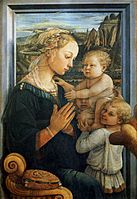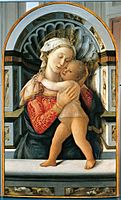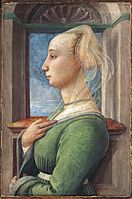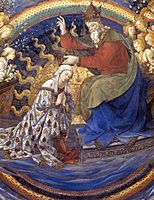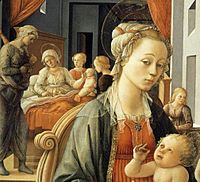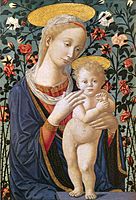Filippo Lippi facts for kids
Quick facts for kids
Filippo Lippi
|
|
|---|---|
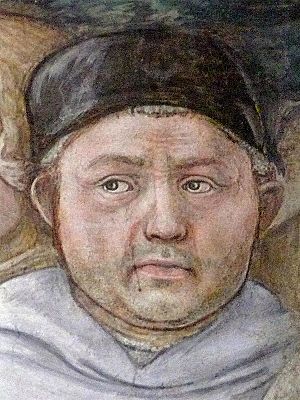
Self-portrait of Fra' Filippo Lippi
|
|
| Born |
Filippo Lippi
c. 1406 Florence, Republic of Florence
|
| Died | 8 October 1469 (aged 62–63) Spoleto, Papal States
|
| Nationality | Italian |
| Other names | Lippo Lippi |
| Known for | Painting, Fresco |
|
Notable work
|
Madonna and Child Enthroned, Annunciation |
| Movement | Early Renaissance |
Fra' Filippo Lippi O.Carm. (around 1406 – 8 October 1469), also known as Lippo Lippi, was a famous Italian painter. He lived during the 15th century, a time known as the Early Renaissance. He was also a Carmelite priest.
Contents
Early Life and Becoming an Artist
Filippo Lippi was born in Florence, Italy, in 1406. His father was a butcher. When Filippo was only two years old, both of his parents died. His aunt, Mona Lapaccia, took him in.
Because his aunt was very poor, she sent Filippo to live at a nearby Carmelite convent when he was eight. This is where he began his education. In 1420, when he was 14, he joined the Carmelite friars at the Priory of Our Lady of Mount Carmel in Florence. The next year, at age 16, he took his religious vows. Around 1425, he became a priest. He lived at the priory until 1432.
Giorgio Vasari, who wrote one of the first books about Renaissance artists, said that Lippi was inspired to paint. He watched another artist named Masaccio working in the Carmine church. Lippi's early paintings, like the Tarquinia Madonna, show Masaccio's influence. Vasari also wrote that Lippi loved to draw. Instead of studying his books, he would fill them with pictures. Because of his strong interest, the head of the priory decided to let him learn painting.
Life as a Painter
In 1432, Filippo Lippi left the monastery. However, he was still a priest. In a letter from 1439, he wrote that he was the poorest friar in Florence. He also mentioned that he had to support six nieces who needed to get married.
Lippi's paintings became very popular. The powerful Medici family in Florence supported him. They asked him to paint important works like The Annunciation and Seven Saints. It is said that Cosimo de' Medici sometimes had to lock Lippi up to make him finish his work! But Lippi was clever and once escaped using a rope made from his bedsheets.
In 1441, Lippi painted a large altarpiece for the nuns of S. Ambrogio. This painting is now a famous artwork in Florence. It shows the Coronation of the Virgin Mary surrounded by angels and saints. The poet Robert Browning later wrote a famous poem about this painting called Fra Lippo Lippi.
In 1452, Lippi became a chaplain for the nuns at the Monastery of St. Mary Magdalene in Florence.
Later Life and Major Works
In 1456, Fra Filippo moved to Prato, a town near Florence. He was there to paint frescoes in the choir of the cathedral. While working on these frescoes in 1458, he met Lucrezia Buti. She was a beautiful young woman who was training to become a nun. Lippi asked her to pose for his painting of the Madonna.
Filippo Lippi spent the end of his life in Spoleto. He was asked to paint scenes from the life of the Virgin for the apse of the cathedral. These paintings show Christ Crowning the Madonna, with angels, wise women, and prophets. This series was finished by his assistant, Fra Diamante, after Lippi passed away.
Filippo Lippi died in Spoleto around October 8, 1469. He was buried in the cathedral. His student, Sandro Botticelli, became a very famous painter himself. Lippi's own son, Filippino Lippi, also became a well-known artist, following in his father's footsteps.
Important Artworks
The frescoes in the choir of the cathedral of Prato are considered Lippi's most important works. They tell the stories of St. John the Baptist and St. Stephen. One famous part is the figure of Salome dancing. This figure influenced later artists like Sandro Botticelli and Lippi's son, Filippino Lippi.
Another important painting is the Nativity in the refectory of S. Domenico in Prato. It shows the baby Jesus on the ground, adored by the Virgin Mary and Joseph.
In the Uffizi in Florence, there is a beautiful painting called "Lippina". It shows the Virgin Mary adoring the infant Christ, who is held by two angels. The National Gallery, London has Lippi's Vision of St Bernard.
Lippi's last major work was the frescoes in the apse of the Spoleto Cathedral. These frescoes show the Annunciation, the Funeral, the Adoration of the Child, and the Coronation of the Virgin. A self-portrait of Lippi, along with his son Filippino and his helpers, can be seen among the people at the funeral scene.
Selected Works
- Enthroned Madonna and Child (1437) - in Rome
- Pietà (1437–1439) - in Milan
- Madonna and Child with Saints (1438) - in Paris
- St. Jerome in Penance (c. 1439) - in Altenburg
- The Annunciation with two Kneeling Donors (c. 1440) - in Rome
- Martelli Annunciation (c. 1440) - in Florence
- Novitiate Altarpiece (c.1440-1445) - in Florence
- Coronation of the Virgin (1441–1447) - in Florence
- Annunciation (c. 1443–1450) - in Munich
- Marsuppini Coronation (after 1444) - in Vatican City
- Annunciation (1445–50) - in Rome
- Annunciation (c. 1449–1459) - in London
- Seven Saints (c. 1449–1459) - in London
- Madonna and Child (c. 1452) - in Florence
- Funeral of St. Jerome (c. 1452–1460) - in Prato
- Stories of St. Stephen and St. John the Baptist (1452–1465) - Fresco cycle, Cathedral of Prato
- Madonna del Ceppo (c. 1452–1453) - in Prato
- Madonna and Child (c. 1455) - in Florence
- Adoration in the Forest (late 1450s) - in Berlin
- Madonna of Palazzo Medici-Riccardi (1466–1469) - in Florence
- Scenes from the Life of the Virgin Mary (1467–1469) - Fresco, apse of the Spoleto Cathedral
- Madonna and Child (between circa 1446 and circa 1447) - at The Walters Art Museum
- Triptych of the Madonna of Humility with saints
Gallery
-
The Nativity, probably c. 1445, National Gallery of Art
-
Madonna with the Child and two Angels (1465), tempera on wood, Uffizi.
See also
 In Spanish: Fra Filippo Lippi para niños
In Spanish: Fra Filippo Lippi para niños


